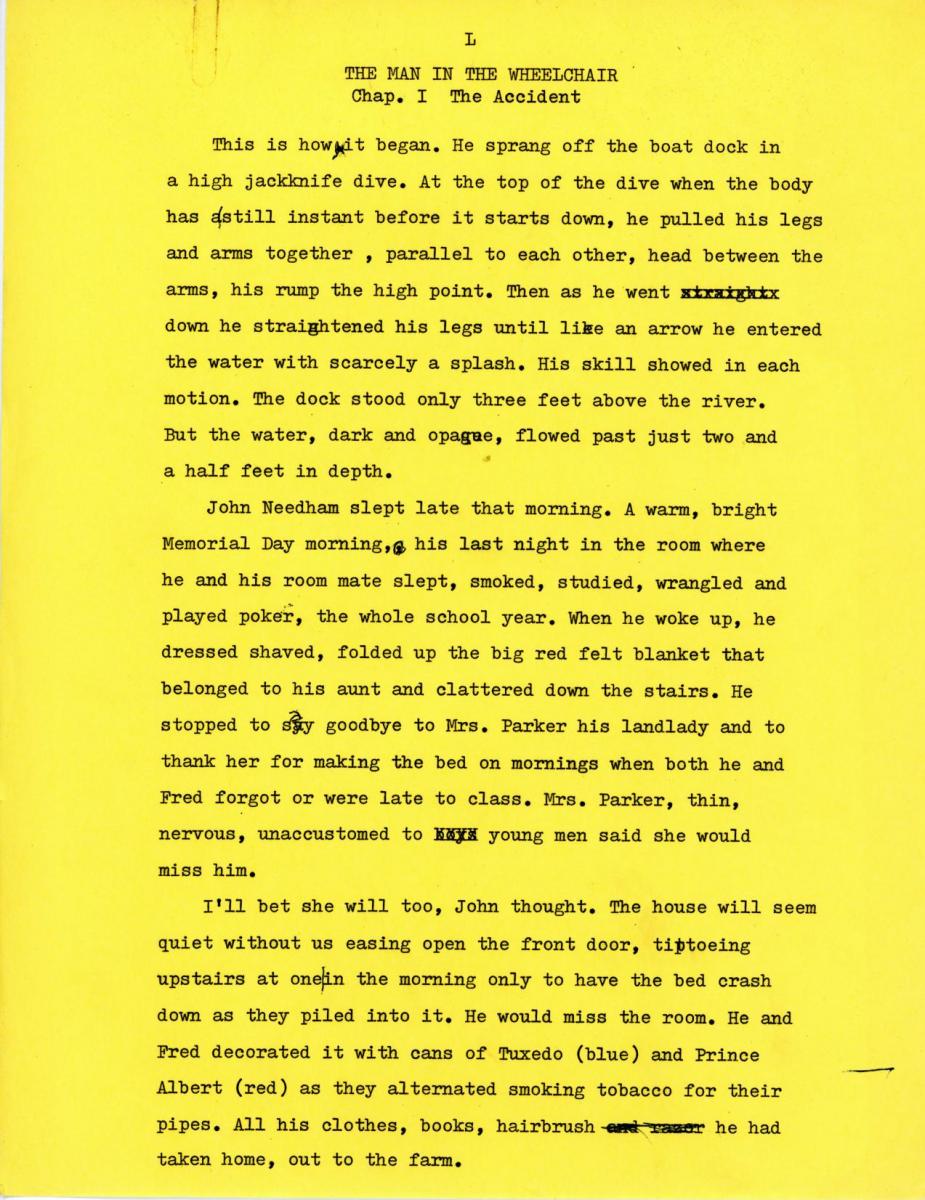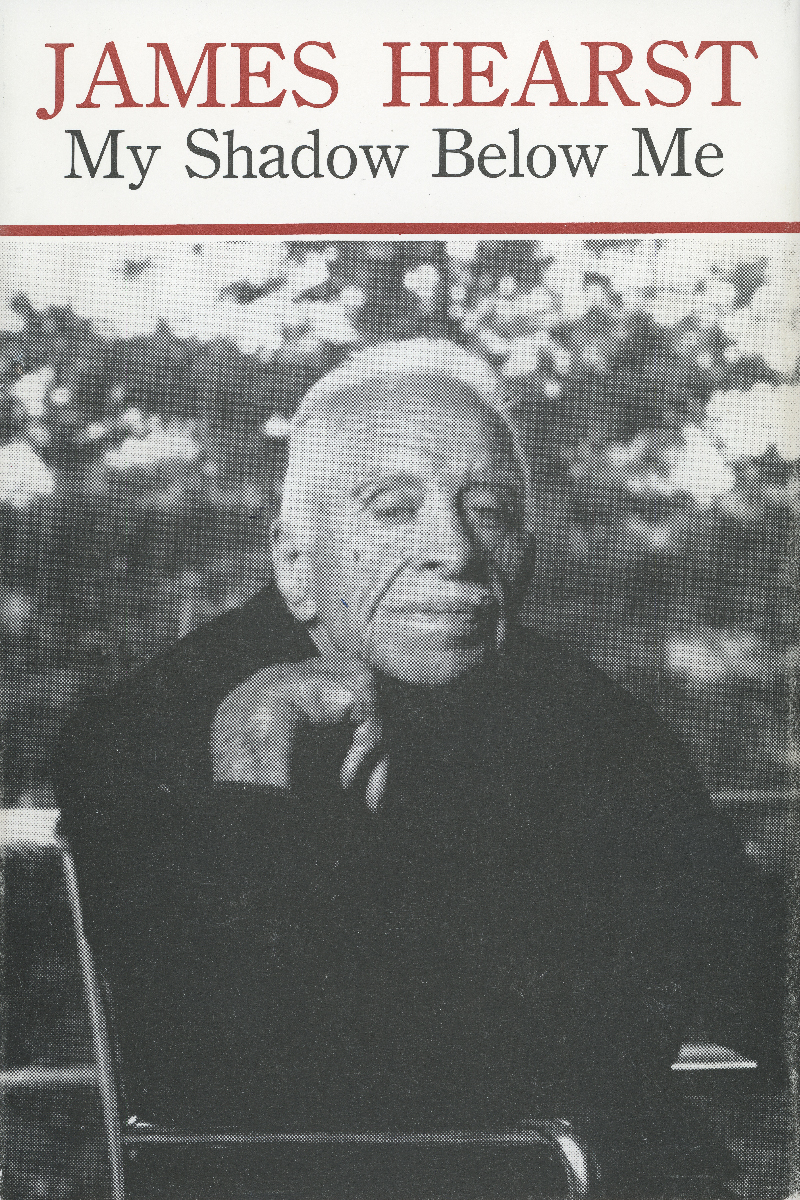My Shadow Below Me: James Hearst's Autobiography
 Hearst’s autobiography shows a life subject to revision, a man who changed roles when it was required of him or when it was allowed and who decidedly favored tenacity over surrender to despair. Drafts of the book from the James Hearst Family Papers housed in Special Collections at University of Northern Iowa's Rod Library show it to have originally been titled The Man in the Wheelchair. And it begins with the swimming accident that changed the trajectory of his life, leaving him unable to fully walk from the age of 19. Throughout the book, Hearst describes his wish for independence and his fear of being left alone. In his view, it would seem, his life revolved around his handicap. But while the autobiography, retitled My Shadow Below Me, does not shy away from darkness, it does not dwell there and simply stop. Rather, it shows Hearst’s transformation from a full-time farmer to a writer and teacher who holds true to his roots.
Hearst’s autobiography shows a life subject to revision, a man who changed roles when it was required of him or when it was allowed and who decidedly favored tenacity over surrender to despair. Drafts of the book from the James Hearst Family Papers housed in Special Collections at University of Northern Iowa's Rod Library show it to have originally been titled The Man in the Wheelchair. And it begins with the swimming accident that changed the trajectory of his life, leaving him unable to fully walk from the age of 19. Throughout the book, Hearst describes his wish for independence and his fear of being left alone. In his view, it would seem, his life revolved around his handicap. But while the autobiography, retitled My Shadow Below Me, does not shy away from darkness, it does not dwell there and simply stop. Rather, it shows Hearst’s transformation from a full-time farmer to a writer and teacher who holds true to his roots.
With Hearst’s accident came time. He spent two years living in a hospital, then after he moved home, he was not immediately strong enough to help with farm work. Hearst did not sit idly in his chair, spinning his wheels while going nowhere. His sister Louise brought him loads of library books, and he gave himself a literary education. He began to teach himself to write, both poetry, which he sent to his Aunt Mamie for critique, and prose, including short stories and a newspaper column called “Things to Think About,” summarizing articles he’d read. “I have no idea why I wrote what I did. I threw it away,” Hearst says in his autobiography, describing his early attempts as “drivel.” “But I kept on.” He would not give up farming, but he was becoming a writer, the“farmer poet.”
 At times of transition, Hearst fell into depression and suicidality. While convalescing in the hospital, he broke into the nurses’ safe and stole morphine, which he kept in his room. And when his first wife, Carmelita, was moved from home to hospital, nearing death, and he was discarding her old medications, he saved back enough morphine and codeine to take his life. Yet, despite a disposition prone to self-destructive thoughts, he not only stayed alive through the loss of his father, mother and first wife, a pregnant girlfriend who fled to France and ceased contact, and the dissolution of his and his brother’s farming partnership, he became the author of 12 books, a professor of English with an honorary degree, a lecturer and workshop instructor, and husband to his second wife, Meryl, to whom he remained married until his natural death.
At times of transition, Hearst fell into depression and suicidality. While convalescing in the hospital, he broke into the nurses’ safe and stole morphine, which he kept in his room. And when his first wife, Carmelita, was moved from home to hospital, nearing death, and he was discarding her old medications, he saved back enough morphine and codeine to take his life. Yet, despite a disposition prone to self-destructive thoughts, he not only stayed alive through the loss of his father, mother and first wife, a pregnant girlfriend who fled to France and ceased contact, and the dissolution of his and his brother’s farming partnership, he became the author of 12 books, a professor of English with an honorary degree, a lecturer and workshop instructor, and husband to his second wife, Meryl, to whom he remained married until his natural death. Hearst lived a life different from the one he originally envisioned, not only because, in his words, “the road had been decided for [him],” but because whenever he stood like a sundial’s gnomon at a pivot point in time, as in his poem “The Sun at Noon,” my shadow below me and I stand in the light, he did not fall back into darkness, nor even stand still for its advance; he stepped forward into each new position and grew there.
—Robyn Groth
Publication Information:
Hearst, James. My Shadow Below Me. Iowa State UP. 1981.
Hearst, James. The Complete Poetry of James Hearst. Edited by Scott Cawelti with a foreword by Nancy Price. University of Iowa Press. 2001.
